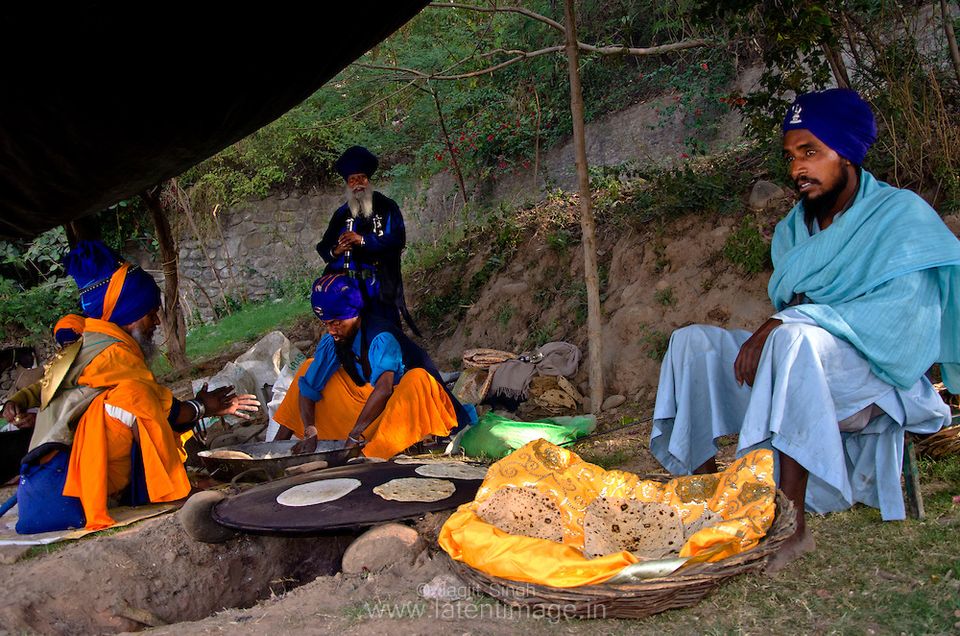Sarbloh & Langar

Nihung Singhs eat from Sarbloh utensils and keep Sarbloh weapons on their bodies, and ask for protection from Sarbloh Akaal Purakh.
An English writer named Edmond Kendler (in Metal of East), writes that Sri Guru Gobind Singh Ji has proved themself to be very wise and having great foresight through starting a tradition of Sarbloh. Among all the spiritual items given greatness, the purest is Sarbloh. This is why Nihung Singhs eat from Sarbloh utensils.
Bibeki Singhs are those who prepare and serve food in Sarbloh Utensils (and make food with their own hands). The equivalent meaning of Bibeki is a contemplator (of what is True and False & ask themselves what will help their spiritual journey and what does not). References to this are still available in the Rehatnamey. Like in Piaara Bhai Dayaa Singh’s Rehitnamey, it is written that Nihung Singhs made Roti/Parshaada on Loha (Metal) over a wood-burning fire.
ਪਾਤ੍ਰ ਸਰਬਲੋਹ ਕੇ, ਭੁਗਤੇ ਅਸਨ ਸੁਆਦਿ॥
ਲਕੜੀ ਕੋ ਭੋਜਨ ਭਖੇ, ਨੀਲ ਬਸਤ੍ਰ ਮਿਰਜਾਦਿ॥
Bhai Desa Singh Ji have stated a special technique in making and serving langar. This technique was asked about by Bhai Nand Lal Ji to Kalgidhar Maharaj Ji. It was used by Puratan Singhs and is currently still used by Nihung Singhs to prepare Langar. This technique is referred to as Bibeki. A part of the technique is to clean the place where the langar is going to be prepared.
ਪਹਿਲੇ ਅਵਨੀ ਸੋਧਨ ਕੀਜੈ॥ ਮਲ ਅਸਥੀ ਲੌ ਦੂਰ ਸੁਟੀਜੈ॥
ਤਾ ਪਾਛੇ ਚੌਂਕਾ ਤਹ ਦੇਈ॥ ਚਹੂੰ ਓਰ ਆਵਰਤ ਕਰੇਈ॥
First, the ground is cleaned where the langar is prepared (through pulling out well-water with a rope and bucket). After this, they bring Sarbloh pots filled with water. If you don’t have Sarbloh then unused new clay pots can be used.
ਜਲ ਭਰ ਗਾਗਰੁ ਤਹਾਂ ਧਰਾਵੈ॥
ਅਥਵਾ ਨਵਤਨ ਕੁੰਭ ਮੰਗਾਵੈ॥
Then clean all the utensils of Langar:
ਸਭ ਭਾਂਜਨ ਕੋ ਮਾਰਜਨ ਕਰੈ॥
ਤਾਂ ਪਾਛੈ ਲੈ ਲੰਗਰ ਧਰੈ॥
Even if dishes are already cleaned, good Bibeki Singhs will still clean them once more. Then there is the discussion about using dried wood to fuel a fire. There is no other instruction about burning anything else as fuel and so, Nihung Singhs only use dried wood (no animal dung etc)
ਸੂਕੀ ਪਾਵਨ ਲੱਕੜੀ ਦੇਈ॥
ਚਖਮਕ ਕਾਢਿ ਅਗਨਿ ਸਚੁ ਲੇਈ॥
Then in the Rehatnamay it is written to keep shoes, cats, dogs, crows, etc. far away from Guru’s Langar.
ਜੂਤਾ ਬੌਕਾ ਮਸ਼ਕ ਬਿੜਾਲਾ॥
ਕੁੱਤਾ ਮੁਸਲਾ ਕਾਕ ਚੰਡਾਲਾ॥
ਗੰਦੀ ਮੰਦੀ ਵਸਤੁ ਜੋ ਆਵਤ॥
ਕੀਜੈ ਦੂਰ ਜਤਨ ਕਰ ਤਾਵਤ॥
Even today, Bibeki Nihung Singhs keep cautious of their hygiene. Further in this Rehatnama: okra (bhindi), radish, lentils, spinach, mustard greens (saag) etc are cooked in langar.
ਮਣ ਭਰ ਰਸਦ ਜੇ ਲੰਗਰ ਜਾਨੈ॥
ਸਵਾ ਦੁਇ ਸੇਰ ਘ੍ਰਿਤ ਤਿਹ ਆਨੈ॥੯੭॥
ਜ਼ਾਦਾ ਹੋਇ ਬਹੁਤ ਸੁ ਨੀਕੋ ॥
ਸੁੱਖ ਹੋਤ ਧਿਆਨ ਰੁ ਜੀ ਕੋ॥
In this Rehatnama it also says that Jhatka Maas should not be made in this langar but outside of langar because there are vegetarian Sikhs eating from langar.
ਬਕਰਾ ਝਟਕਾ ਬੀਚ ਨ ਕਰੇ॥
ਅਵਰ ਮਾਸ ਨਹਿ ਲੰਗਰ ਪਰੇ॥
ਜੋ ਸਨ ਹੋਇ ਤ ਦੂਰ ਕਰਾਵੈ॥
ਨਿਜ ਬਰਤਾਰਾ ਤਹਾਂ ਲੈ ਜਾਵੈ॥੧੦੫॥
ਦੇਗ ਅਸਨ ਕੇ ਹੈਂ ਸਭ ਭਾਗੀ॥
ਬ੍ਰਾਹਮਨ ਖਤ੍ਰੀ ਸਭ ਅਨੁਰਾਗੀ॥
ਤਾਂ ਤੇ ਯਾ ਸਿਛਾ ਸੁਨ ਲੀਜੈ॥
ਦੇਗ ਮਾਹਿ ਨਹਿ ਮਾਸ ਅਨੀਜੈ॥੧੦੬॥
So among Nihung Singhs, this maryada is still maintained. This is consistent at Tarna Dal’s Headquarters Baba Bakala Sahib and all of Tarna Dal’s major chhaunis, Shaheedi Bagh (Sri Anandpur Sahib), and Samadha Baba Naudh Singh Ji, and especially in the Dal Panth. After consuming Bakra at Shaheedi Bagh, a Singh cannot go to the Langar unless they have done Ishnaan. This is because there are some Nihung Singhs who do not have Chhatri-Bhojan and others that do. This is the maryada which is maintained among Nihung Singhs.
After preparing the langar, Puratan Nihung Singhs used to give a call out and the langar nagara would be struck. At this time, the hungry and poor would receive langar then if any remains then the Singhs would eat it themselves.
ਦੇਤ ਅਵਾਜਾ ਭੁੱਖਾ ਕੋਈ।
ਆਓ ਬੈਠੁ ਤਿਆਰ ਹੈ ਸੋਈ॥
ਬਚੇ ਤੌ ਆਪ ਖੈ ਹੈ।
ਨਹੀ ਤੌ ਲੰਗਰ ਮਸਤ ਬੜੈਹੈ ॥
Even today after preparing langar, the nagara is struck and the poor and hungry get served.
–
Maaf Karna for the mistakes. As always these translations are being offered in your laps Ji
~Aaeenaa

